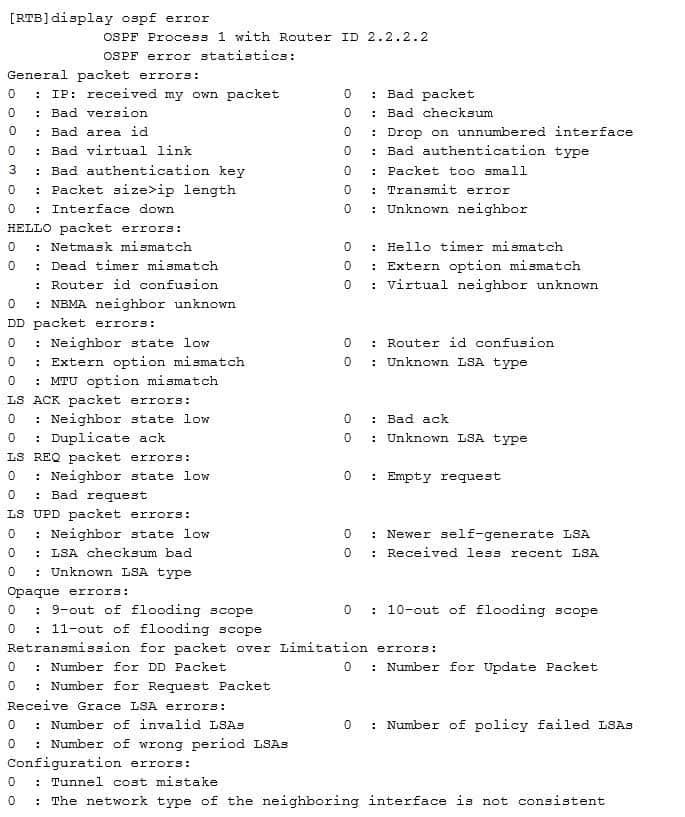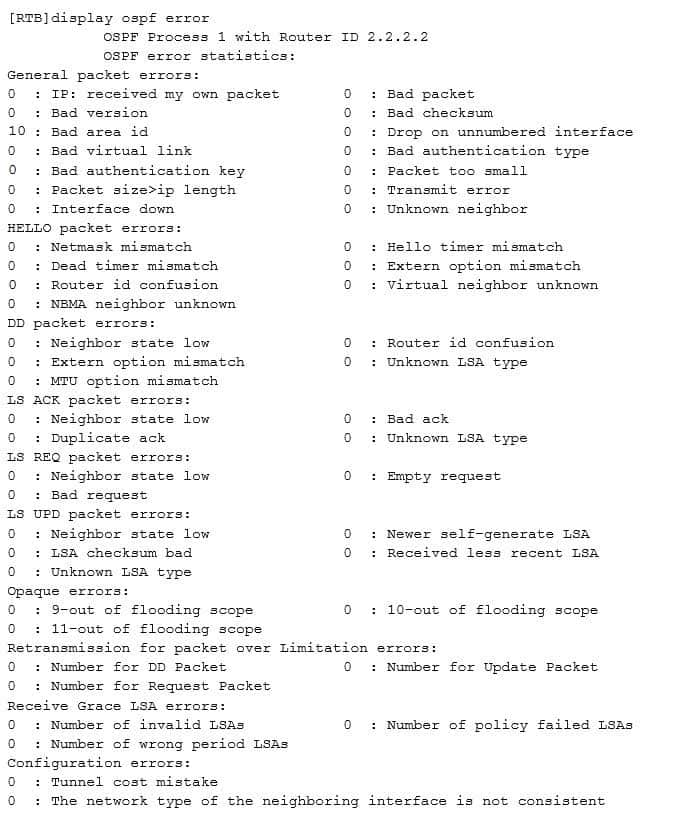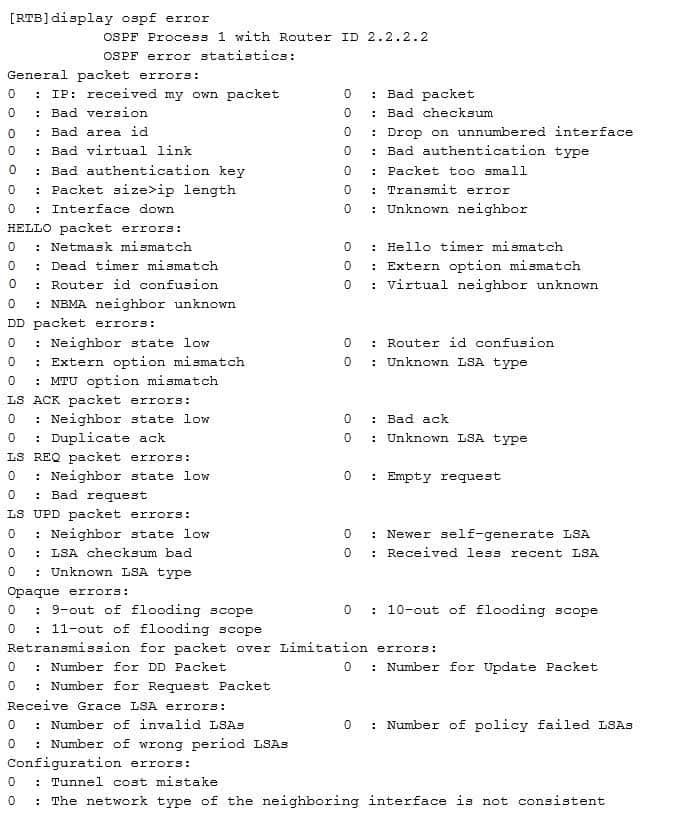H12-224 : HCNP-R&S Fast Track (Huawei Certified Network Professional – Routing & Switching Fast Track) : Part 20
-
Which of the following addresses can be used on a public network? (Choose two.)
- 172.30.0.1/16
- 127.254.11.15/16
- 172.15.12.7/16
- 193.168.10.4/16
-
Different network segments can be in the same OSPF area and the same network segment can be in different OSPF areas.
- True
- False
-
What is the maximum bits of a Class B address can be used for subnet?
- 8
- 14
- 16
- 22
-
A company reserves the network segment 172.29.100.0/26 for some remote small-scale sites and each site has 5 IP devices to connect to this network segment. Which of the following VLSM masks can be used to provide minimum number of hosts to meet such a requirement?
- /27
- /28
- /29
- /30
-
Which of the following network or link type is not the basic network or link type defined in OSPF?
- P2P
- P2MP
- Broadcast
- Virtual link
-
An OSPF neighbor relationship fails to be established and the display ospf error command output is as follows.

H12-224 HCNP-R&S Fast Track (Huawei Certified Network Professional – Routing & Switching Fast Track) Part 20 Q06 023 Which of the following is the possible cause?
- Router IDs conflict.
- Area IDs are mismatched.
- Network masks are inconsistent.
- Authentication types are inconsistent.
-
Which of the following statements about LACP are true? (Choose two.)
- It complies with IEEE 802.3az.
- A device enabled with LACP exchanges Link Aggregation Control Protocol Data Units (LACPDUs) with its peer.
- Devices at both ends determine the active interface according to the interface priority of the active device.
-
Which of the following are end-to-end link protection modes? (Choose three.)
- 1: 1
- M: N
- N: 1
- 1+1
-
An OSPF neighbor relationship fails to be established and the display ospf error command output is as follows.

H12-224 HCNP-R&S Fast Track (Huawei Certified Network Professional – Routing & Switching Fast Track) Part 20 Q09 024 Which of the following is the possible cause?
- Router IDs conflict.
- Area IDs are mismatched.
- Network masks are inconsistent.
- Authentication types are inconsistent.
-
Which of the following statements about BFD Echo packets are true? (Choose two.)
- The Echo packet format is not defined in BFD.
- The Echo packet format is defined in BFD.
- Echo packets use UDP destination port number 3785.
- Echo packets use UDP destination port number 3784.
-
An OSPF neighbor relationship fails to be established and the display ospf error command
output is as follows.
H12-224 HCNP-R&S Fast Track (Huawei Certified Network Professional – Routing & Switching Fast Track) Part 20 Q11 025 Which of the following is the possible cause?
- Router IDs conflict.
- Area IDs are mismatched.
- Network masks are inconsistent.
- Authentication passwords are inconsistent.
-
ABRs of a Stub area do not flood Type-5 and Type-4 LSAs to the Stub area. Therefore, the Stub area does not have the external AS routing capability. ABRs of the Stub area advertise a default route to the stub area to guide packet forwarding to the external of the AS.
- True
- False
-
Assume that the subnet mask is 255.255.255.248. Which of the following addresses are valid host addresses? (Choose three.)
- 192.168.200.87
- 196.123.142.190
- 223.168.210.100
- 220.100.100.154
-
Which of the following statements is false?
- An ABR maintains an LSDB for each area. There are many LSDBs on an ABR.
- The metric of an ASE LSA can be specified when an external route is imported. The default value is 1.
- The external routing information carries a Tag label for transmitting additional information of the route. It is commonly used in a routing policy. The default value of the Tag label is 0.
- The Link State ID in an ASBR-Summary-LSA is the Router ID of the ASBR.
-
If the Router Priority of a router is set to 0, this router cannot be elected as a DR or a BDR.
- True
- False
-
Only Router-LSAs and Network-LSAs are involved in intra-area route calculations.
- True
- False
-
Which of the following statements about Flush packets in a Smart Link group are true? (Choose three.)
- A Smart Link group sends Flush packets to instruct other devices to update the address table.
- Flush packets use IEEE 802.3 encapsulation.
- The destination MAC address of Flush packets is an unknown unicast address, which is used to distinguish protocols.
- The destination MAC address of Flush packets is a special multicast address, which is used to distinguish protocols.
-
Which of the following statements about Stub areas is false?
- The difference between a Stub area and a Totally Stubby area is that the Totally Stubby area cannot contain summary-LSAs.
- The ABR in the Stub area generates a default route to guide forwarding of packets destined for other area.
- A Transit area cannot be configured as a Stub area.
- Any Stub area can be configured as a Totally Stubby area.
-
Each router running OSPF has a router ID. A router ID is a 32-bit integer and uniquely identifies a router. Hence, even of routers in different ASs, the router IDs must be different.
- True
- False
-
Which of the following statements about link aggregation are true? (Choose three.)
- Link aggregation can be performed in manual load balancing or LACP mode. In manual loading balancing mode, LACP is enabled; in LACP mode, LACP is enabled too.
- In manual load balancing mode, all active member interfaces forward data and perform load balancing.
- In static LACP mode, the creation of the Eth-Trunk and the addition of member interfaces to the Eth-Trunk are performed manually. Compared with link aggregation in manual load balancing mode, active interfaces in static LACP mode are selected by sending LACP Data Units (LACPDUs).
- In dynamic LACP mode, the creation of the Eth-Trunk, the addition of member interfaces, and the selection of active interfaces are performed based on LACP negotiation.
Subscribe
0 Comments
Newest